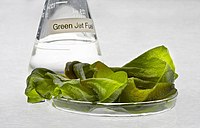
Photo from wikipedia
Abstract This paper discusses the role of water cavities to break palm oil into glycerol and fatty acids. The cavities were generated by injecting water via a nozzle into palm… Click to show full abstract
Abstract This paper discusses the role of water cavities to break palm oil into glycerol and fatty acids. The cavities were generated by injecting water via a nozzle into palm oil in the Hele-Shaw cell at room temperature, without catalyst and pressure of 2, 6, 10 to 16 MPa. The hydrolysis reaction between triglyceride with water was verified by the Amsterdam density function (ADF) software. This suggest that production of glycerol by water jet impinging into palm oil bath is determined by three factors: the lowest static pressure produced by the jet, the largest foam of cavities produced by the static pressure, and the most energetic vibration generated during cavities formation. The cavities have very high surface tension energy, which not only breaks the palm oil into glycerol and fatty acids, but also modifies some fatty acids molecular structure.
Journal Title: Ain Shams Engineering Journal
Year Published: 2021
Link to full text (if available)
Share on Social Media: Sign Up to like & get
recommendations!